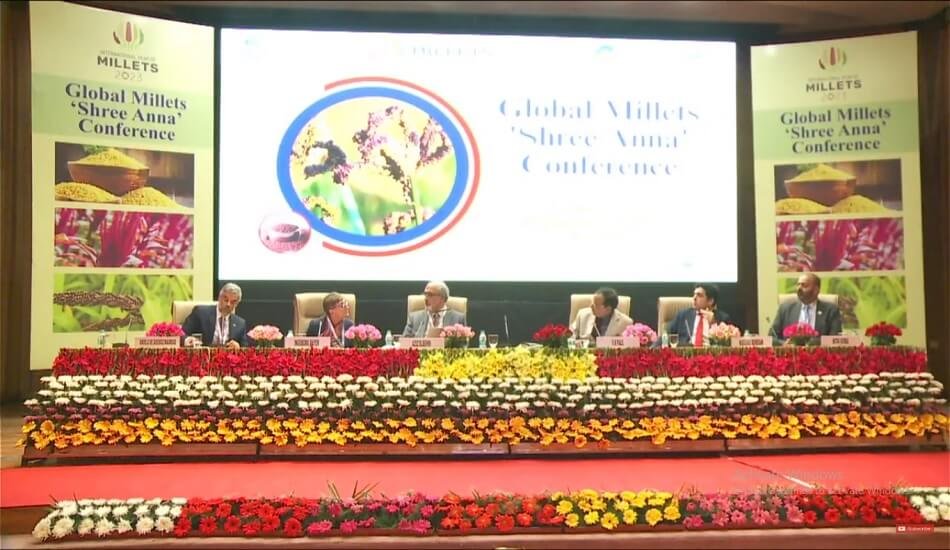India hosts Global Millets Conference to strategize global production, consumption
On Saturday, a ministerial round table of millets was held in New Delhi following the inaugural session of the Global Millets (Shree Anna) Conference.
The meeting was attended by ministers from Guyana, Mauritius, Sri Lanka, Sudan, Suriname, and Zambia, as well as the Permanent Secretaries of Agriculture from Gambia and Maldives and the Director General of the Nigerian Millets Initiative.
Also Read | PV Satheesh, Millet man, who helped women reinvent self-sustaining agri, died
In order to commemorate 2023 as the International Year of Millets, India hosted its first mega-global event, the Global Millets (Shree Anna) Conference in Delhi (IYM). The United Nations’ goal in designating 2023 as the International Year of Millets on India’s initiative is to raise awareness of millets for food security and nutrition, increase investment in R&D and extension, and inspire stakeholders to improve millet production, productivity, and quality.
On Saturday, Prime Minister Narendra Modi presided over the global event, which was attended by Union Minister of Agriculture and Farmers Welfare Narendra Singh Tomar, among other ministers.
Tomar emphasised India’s role in promotion during his opening remarks at the Ministerial Round Table, citing the country’s status as the world’s largest producer and second largest exporter of millets.
India produced millets in the range of 13.71 to 18.02 million tonnes over the last five years. Since 2018-19, the government has been implementing a Sub-Mission on Nutri-Cereals (Millets) under the National Food Security Mission (NFSM) in 212 Districts across 14 States to promote millets and meet increased demand for millets.
During the export year 2022-23 (April to November), India exported 104,146 metric tonnes of millets worth Rs 365.85 crores.
Along with a focus on research and innovation in production, farmer organisations, or FPOs, are being encouraged to increase aggregation, production, and processing. Tomar expressed satisfaction with the operation of many start-ups in millets with government assistance.
In addition, visiting ministers from major millets producing countries shared their experiences in promoting millet production, consumption, and branding in their respective countries. They were all in favour of closer cooperation among major millets producing countries.
According to a government release, all countries wished for India to provide good seed of improved millets, as well as assistance in establishing small scale mechanisation and capacity building. All ministers agreed that indigenous millet crops should be promoted in their countries in order to wean people off wheat.
Also Read | Karnataka introduces millets incentive scheme for horticultural exports
‘They proposed that millets be designated as priority crops and included on the agenda of all international meetings. Some non-traditional millets-growing countries, such as Guyana, have shifted to millets cultivation as a result of the International Year of Millets. India assured these countries that it would provide all necessary knowledge, technology, and capacity building ‘According to the press release.
Millets International Year 2023 has officially begun
The Indian government, led by Prime Minister Narendra Modi, spearheaded a United Nations General Assembly (UNGA) resolution to declare 2023 the International Year of Millets, and India’s proposal was supported by 72 countries.
What exactly are millets?
Millet is a common name for small-seeded grasses that are also known as Nutri-cereals. Sorghum (jowar), pearl millet (bajra), finger millet (ragi), little millet (kutki), foxtail millet (kakun), proso millet (cheena), barnyard millet (sawa), and kodo millet are just a few examples (kodon).
Millets, an important staple cereal crop for millions of smallholder dryland farmers in Sub-Saharan Africa and Asia, provide nutrition, resilience, income, and livelihood for farmers, and have a variety of uses including food, feed, fodder, biofuels, and brewing.
Millets’ significance and benefits
Millets are nutritionally superior to wheat and rice because they contain more protein and have a more balanced amino acid profile. Millets also contain a variety of phytochemicals that, due to their anti-inflammatory and anti-oxidative properties, have therapeutic properties.
In addition to being climate resilient, millet grains are high in nutrients such as carbohydrates, protein, dietary fibre, and good-quality fat, as well as minerals such as calcium, potassium, magnesium, iron, manganese, zinc, and B complex vitamins.
Most importantly, millet production does not rely on chemical fertilisers.
The History of Millets in India
Millets were traditionally consumed, but due to the Green Revolution’s push for food security in the 1960s, millets were less consumed and almost forgotten.
Millets made up around 40% of all cultivated grains prior to the Green Revolution, but this has since dropped to around 20%.
Also Read | Millets included in FSSAI’s notification of comprehensive group standards
India grows all nine commonly known millets and is the world’s largest producer and fifth-largest exporter of millets.
8 Most Indian states grow one or more millet crop species. The major millets producing states are Rajasthan, Uttar Pradesh, Haryana, Gujarat, Madhya Pradesh, Maharashtra, Karnataka, Tamil Nadu, Andhra Pradesh, and Telangana.


















Add Comment